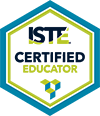Accessible to All: Guiding Learners to Construct Their Accessibility Toolbox
,
Colorado Convention Center, Bluebird Ballroom Lobby, Table 34
Presenters


@TechyBeckyYoung

Session description
Purpose & objective
The purpose of this presentation is to equip educators with the knowledge and skills to effectively integrate assistive technology into their teaching practices to support struggling students. It addresses the challenge of accommodating diverse learning needs in the classroom and offers practical solutions through technology interventions.
Participants will be able to:
- Understand Assistive Technology and the UDL framework. Participants will solidify their understanding of what assistive technology is, its relevance for today’s learners, and the categories and types available.
- Select and implement assistive technology: Participants will feel confident in guiding students to select assistive technology tools and strategies based on the indicators of student need and preference.
- Effectively integrate and use: Participants will understand how to help learners integrative assistive technology in their daily tasks. Participants will understand how to model their own usage of assistive technology to foster an inclusive classroom environment.
- Monitor, evaluate, and adjust to learner development: Participants will understand how to monitor and evaluate the usage and effectiveness of assistive technology for learners in their classrooms. Participants will learn how to employ surveys and student interviews to understand how assistive technology is being used, and how to recommend adjustments over time.
Success is measured through:
- Surveys and Assessments: Pre-and post-presentation assessments to gauge the knowledge and confidence levels of participants.
- Feedback and Evaluation: Collecting feedback from educators on the effectiveness and ease of implementation of assistive technology tools.
- Participant Sharing and Case Studies: Sharing success stories of educators who have successfully integrated assistive technology into their teaching.
By the end of this presentation, educators will not only understand the importance of assistive technology but also possess the skills and resources needed to empower struggling students, creating a more inclusive and supportive learning environment.
Outline
Participants will be invited to a PearDeck session as an option to engage with the presentation. The resources will be available in other formats too (modeling real-life Accessibility tools for adult learners).
Participants will interact with the presenter using PearDeck and with their peers both digitally and conversationally. The UDL guidelines will be used to create session resources and will be modeled throughout the session.
1) Check-in: Engagement question and join PearDeck session (5 minutes)
2) Types of Accessibility Tools: presentation of information with opportunities for participant reflection (10 minutes)
3) Principles of guiding learners to use Accessibility Tools: presentation of information with opportunities for participant reflection(10 minutes)
4) Real-life examples of how learners respond to using Accessibility Tools: participant-chosen exploration with opportunities for reflection (20 minutes)
5) Final reflection and Q&A (15 minutes)
Supporting research
Websites include:
CAST website: https://www.cast.org/impact/universal-design-for-learning-udl
UDL Guidelines: https://udlguidelines.cast.org/
Books include:
UDL Now!: A Teacher's Guide to Applying Universal Design for Learning 3rd ed. Edition by Dr. Katie Novak
Universal Design Daily: 365 Ways to Teach, Support, & Challenge All Learners Using UDL by Dr. Paula Kluth
Session specifications
Laptop: Chromebook, Mac, PC
Tablet: Android, iOS, Windows
Learning Designer
- Collaborate with educators to design accessible and active digital learning environments that accommodate learner variability.
Designer
- Use technology to create, adapt and personalize learning experiences that foster independent learning and accommodate learner differences and needs.
Empowered Learner
- Students articulate and set personal learning goals, develop strategies leveraging technology to achieve them and reflect on the learning process itself to improve learning outcomes.
 Return
Return Participate and share: Poster
Participate and share: Poster  Trips and Tours
Trips and Tours